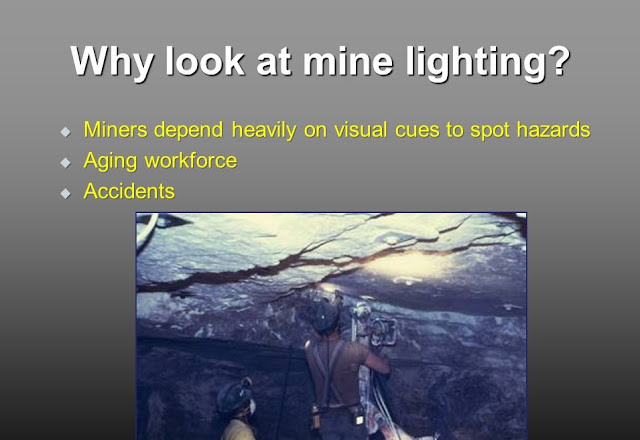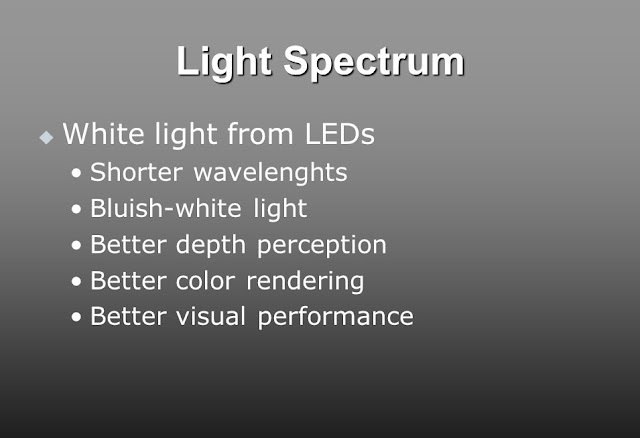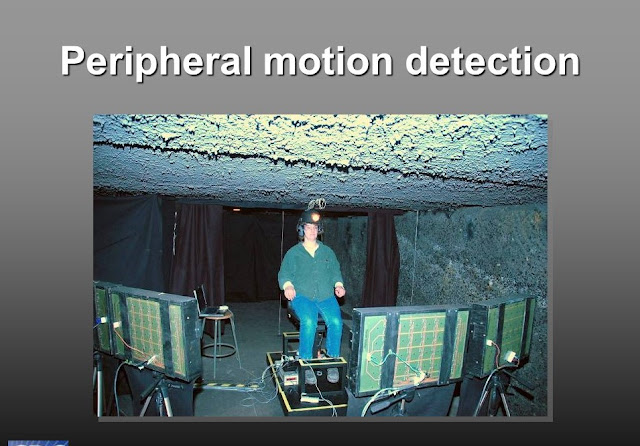Mine Illumination and Solid-State Lighting.
Mine Illumination
and
Solid-State Lighting
Dr. John J. Sammarco
NIOSH
Pittsburgh Research Laboratory
Agenda
◆ Why is lighting important?
◆ Age and vision
◆ History of lighting
◆ Lighting safety & accidents
◆ High brightness light emitting diodes
(HB LEDs)
◆ NIOSH lighting research
Why look at mine lighting?
Mining…“the most difficult lighting
environment in the world”
Illumination Engineering Society of North America, 2003.
◆ Miners depend heavily on visual cues to spot hazards
◆ Aging workforce
◆ Accidents
Why look at mine lighting?
Age Effects on Vision
◆ Night vision decreases with age
• Smaller pupil
• Eye less able to adapt to light
• Fewer rod receptors
• Cloudy eye lens
Age Effects on Vision
Yellowing of Lens
(age in years)
Degradation of lens
decreases effective light
level and effective contrast
(due to scatter)
Average miner 43 yrs old
40% less light than 20 yrs old
◆ Improved lighting may help miners avoid accidents:
• Slip/trip/falls
• Falls of ground
• Striking/pinning
◆ An MSHA study of metal/nonmetal mining concluded that
current lighting systems are inadequate.
Why look at mine lighting?
Safety & Lighting
The percentage of accidents declines as illuminance is
increased in industrial (non-mining) work areas
Source (Walton et al., 2005)
Candle holders
with candles
A Brief History of Lighting
Oil wick lamps improved safety
by containing open flames. Costs
were also lower, and miners
found them easier to use than
candles.
Photos: Royal BC Museum, British Columbia, Canada, http://www.royalbcmuseum.bc.ca/
Oil Lamps
Photo: Royal BC Museum, British Columbia, Canada, http://www.royalbcmuseum.bc.ca/
Quotation: Where the Sun Never Shines, Priscilla Long, Paragon House, New York, 1989.
The transition to helmet-mounted
lighting began with the introduction
of the carbide lamp.
Carbide lamps
The introduction of the
incandescent lamp eliminated
concerns about open
flames within the mine.
The light from a small, steadily
burning incandescent filament
was much more controllable
than the light from an open
flame. Enclosed within a
directional reflector, it became
the standard, unchanged to
this day.
Photos: Royal BC Museum, British Columbia, Canada, http://www.royalbcmuseum.bc.ca/,
Cape Breton Mine Museum, www.minersmuseum.com
Incandescent Lights
What is light?
What is light?
Electromagnetic radiation
Light Spectrum
◆ White light from LEDs
• Shorter wavelenghts
• Bluish-white light
• Better depth perception
• Better color rendering
• Better visual performance
Spectral Power Distribution
Lighting technologies
Type Life
(hrs)
Cost Specular*
color
temp.
Efficiency
(lumens/watt)
Shock proof
Incandescent 1,500 $7 2800oK 14 no
Halogen 2,500 $6 3200oK 24 no
HID 10,000 $20 4000oK 80 no
Solid-state
LED
50,000
+
$8 5500oK 70
(prototypes @
110)
yes
•Lower specular color temperatures indicate a yellowish light;
•higher temperatures indicate a whiter light.
Light Emitting Diodes (LEDs)
LEDs are semi-conductors; they don't have a filament that will burn out.
They are illuminate by the movement of electrons in a semiconductor.
LED’s
Luminaires
Light Emitting Diodes (LEDs)
• Advantages:
1. Lower power requirements
2. Long Life (>50,000 hours)
3. Small size
4. Sturdy
5. “White, shorter
wavelength” light
NIOSH
Mine Lighting Research
Reducing underground mining
mishaps by improving
mine illumination
Project Scope
Underground lighting:
◆ Cap lamp (coal)
◆ Preblast lighting (metal/nonmetal)
◆ Machine lighting (coal)
Cap Lamps
LED Cap Lamp
2 lb. battery, 5 year LED life
Additional Personal lighting
5 lb. battery
Machine Lighting
Preblast Lighting
◆ inspect roof & back
◆ loading of explosives
Specific aim summary
◆ Does the color (spectral power distribution)
from white LEDs:
• Improve visual performance?
• Reduce glare?
◆ Can advantages of LEDs (small, robust, high
efficiency, etc) enable new designs to:
• Improve visual performance?
• Reduce glare?
• Realize new safety applications?
NIOSH
Mine Illumination Lab
Glare tests
Peripheral motion detection
Slip/trip/fall hazards
Mean time to detect an object
Incandescent cap lamp was slowest
Lighting prototypes
Questions






































Comments
Post a Comment